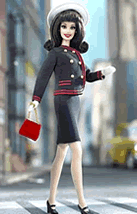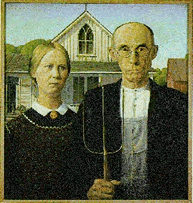|
Text A Five Famous Symbols of American Culture The Statue of Liberty
That same year Bartholdi had assembled the statue's right arm and torch, and displayed them in Philadelphia. It is said that he had used his wife's arm as the model, but felt her face was too beautiful for the statue. He needed someone whose face represented suffering yet strength, someone more severe than beautiful. He chose his mother. The Statue of Liberty was dedicated on an island in Upper New York Bay in 1886. It had his mother's face and his wife's body, but Bartholdi called it "my daughter, Liberty". Barbie
Barbara Handler was the daughter of Elliot and Ruth Handler, co-founders of the Mattel Toy Company. Ruth came up with the idea for Barbie after watching her daughter play with paper dolls. The three-dimensional model for Barbie was a German doll ― a joke gift for adults described as having the appearance of "a woman who sold sex". Since her introduction in 1959, Barbie has become the universally recognized Queen of the Dolls. Mattel says the average American girl owns ten Barbie dolls, and two are sold somewhere in the world every second.
American Gothic Grant Wood instantly rose to fame in 1930 with his painting American Gothic, an often-copied interpretation of the solemn pride of American farmers. The painting shows a serious-looking man and a woman standing in front of a farmhouse. He was strongly influenced by medieval artists and inspired by the Gothic window of an old farmhouse, but the faces in his composition were what captured the world's attention. Wood liked to paint faces he knew well. For the grave farmer he used his dentist, a sour-looking man. For the woman standing alongside him, the artist chose his sister, Nan. He stretched the models' necks a bit, but there was no doubt who posed for the portrait. Nan later remarked that the fame she gained from American Gothic saved her from a very boring life. The Buffalo Nickel Today, American coins honor prominent figures of the US government ― mostly famous former presidents. While white people had previously been used as models for most American coins, famed artist James Earle Fraser went against tradition by using three actual American Indians as models for his creation. Uncle Sam
During a later war in 1812, Wilson gained a position inspecting meat for US Army forces, working with a man who had signed a contract with the government to provide meat to the army. Barrels of meat supplied to the army were stamped "EA-US", identifying the company (EA) and country of origin (US). According to one story, when a government official visited the plant and asked about the letters, a creative employee told him "US" was short for "Uncle Sam" Wilson. Soon soldiers were saying all Army supplies were from "Uncle Sam". After the war, a character called Uncle Sam began appearing in political cartoons, his form evolving from an earlier cartoon character called Brother Jonathan that was popular during the American Revolution. Uncle Sam soon replaced Brother Jonathan as American's most popular symbol. The most enduring portrait of Uncle Sam was created by artist James Montgomery Flagg in his famous army recruiting posters of World Wars I and II. That version ― a tall man with white hair and a small white beard on his chin, a dark blue coat and a tall hat with stars on it ― was a self-portrait of Flagg. Text B Ernest Hemingway's story is about an incident that happens between a father and his son. The small boy's misunderstanding of the difference in measuring temperature on a Fahrenheit and a Celsius scale causes him to believe that he is dying of a high fever. However, the father doesn't realize it until very late that day... A DAY'S WAIT Ernest Hemingway He came into the room to shut the windows while we were still in bed and I saw he looked ill. He was shivering, his face was white, and he walked slowly as though it ached to move. "What's the matter, Schatz?" "I've got a headache." "You better go back to bed." "No. I'm all right. " "You go to bed. I'll see you when I'm dressed. " But when I came downstairs he was dressed, sitting by the fire, looking a very sick and miserable boy of nine years. When I put my hand on his forehead I knew he had a fever. "You go up to bed," I said, "You're sick." "I'm all right," he said. When the doctor came he took the boy's temperature. "What is it?" I asked him. "One hundred and two." Downstairs , the doctor left three different medicines in different colored capsules with instructions for giving them. One was to bring down the fever, another purgative, the third to overcome an acid condition. The 20 germs of influenza can only exist in an acid condition, he explained. He seemed to know all about influenza and said there was nothing to worry about if the fever did not go above one hundred and four degrees. This was a light epidemic of flu and there was no danger if you avoided pneumonia. Back in the room I wrote the boy's temperature down and made a note of the time to give the various capsules. "Do you want me to read to you?" "All right. If you want to," said the boy. His face was very white and there were dark areas under his eyes. He lay still in the bed and seemed very detached from what was going on. I read aloud from Howard Pyle's Book of Pirates; but I could see he was not following what I was reading. "How do you feel, Schatz?" I asked him. "Just the same, so far," he said. I sat at the foot of the bed and read to myself while I waited for it 35 to be time to give another capsule. It would have been natural for him to go to sleep, but when I looked up he was looking at the foot of the bed, looking very strangely. "Why don't you try to sleep? I'11 wake you up for the medicine. " "I'd rather stay awake." After a while he said to me, "You don't have to stay in here with me, Papa, if it bothers you." "It doesn't bother me." "No, I mean you don't have to stay if it's going to bother you. I thought perhaps he was a little lightheaded and after giving him the 45 prescribed capsules at eleven o'clock I went out for a while. It was a bright, cold day, the ground covered with a sleet that had frozen so that it seemed as if all the bare trees, the bushes, the cut brush and all the grass and the bare ground had been varnished with ice, I took the young Irish setter for a walk up the road and along a frozen creek, but it was difficult to 50 stand or walk on the glassy surface and the red dog slipped and slithered and I fell twice, hard, once dropping my gun and having it slide away over the ice. We flushed a covey of quail under a high clay bank with overhanging brush and I killed two as they went out of sight over the top of the bank. Some of the covey lit in trees, but most of them scattered into brush piles and it was necessary to jump on the ice-coated mounds of brush several times before they would flush. Coming out while you were poised unsteadily on the icy, springy brush they made difficult shooting and I killed two, missed five, and started back pleased to have found a covey close to the house and happy there were so many left to on another day. At the house they said the boy had refused to let anyone come into the room. "You can't come in," he said. "You mustn't get what I have." I went up to him and found him in exactly the position I had left him, white-faced, but with the tops of his cheeks flushed by the fever, staring still, as he had stared, at the foot of the bed. I took his temperature. "What is it?" "Something like a hundred," I said. It was one hundred and two and four tenths. "It was a hundred and two," he said. "Who said so?" "The doctor." "Your temperature is all right," I said. "It's nothing to worry about." "I don't worry," he said, "but I can't keep from thinking." "Don't think," I said. "Just take it easy." "I'm taking it easy," he said and looked straight ahead. He was evidently holding tight onto himself about something. "Take this with water." "Do you think it will do any good?" "Of course it will." I sat down and opened the Pirate book and commenced to read, but I could see he was not following, so I stopped. "About what time do you think I'm going to die?" he asked. "What?" "About how long will it be before I die?" "You aren't going to die. What's the matter with you?" "Oh, yes, I am. I heard him say a hundred and two. " "People don't die with a fever of one hundred and two. That's a silly way to talk." "I know they do. At school in France the boys told me you can't live with forty-four degrees. I've got a hundred and two. " He had been waiting to die all day, ever since nine o'clock in the morning "You poor Schatz, "I said. "Poor old Schatz. It's like miles and kilometers. You aren't going to die. That's a different thermometer. On that thermometer thirty-seven is normal. On this kind it's ninety-eight. " "Are you sure?" "Absolutely," I said. "It's like miles and kilometers. You know, like how many kilometers we make when we do seventy miles in the car?" "Oh," he said. But his gaze at the foot of the bed relaxed slowly. The hold over himself relaxed too, finally, and the next day it was very slack and he cried very easily at little things that were of no importance.
|
 In the mid-1870s, French artist Frederic Auguste Bartholdi was working on an enormous project called Liberty
In the mid-1870s, French artist Frederic Auguste Bartholdi was working on an enormous project called Liberty  Before all the different types of Barbie dolls for sale now, there was just a single Barbie. Actually, her name was Barbara.
Before all the different types of Barbie dolls for sale now, there was just a single Barbie. Actually, her name was Barbara.  Barbie's boyfriend, Ken, was introduced in 1961 and named after Barbara's brother. The real Ken, who died in 1994, was disgusted by the doll that made his family famous. "I don't want my children to play with it," he said in 1993.
Barbie's boyfriend, Ken, was introduced in 1961 and named after Barbara's brother. The real Ken, who died in 1994, was disgusted by the doll that made his family famous. "I don't want my children to play with it," he said in 1993.  Fourteen-year-old Sam Wilson ran away from home to join his father and older brothers in the fight to liberate the American colonies from the British during the American Revolution. At age 23, he started a meatpacking business and earned a
Fourteen-year-old Sam Wilson ran away from home to join his father and older brothers in the fight to liberate the American colonies from the British during the American Revolution. At age 23, he started a meatpacking business and earned a 
